Your flowerbox can transform from a simple container into a stunning display of color and texture with the right plant combinations. Whether you’re working with a sunny windowsill or a shaded balcony, you’ll find options that match your space and maintenance preferences. From dramatic cascading blooms to drought-resistant varieties, these seven carefully curated plant groupings will help you create an eye-catching outdoor feature that flourishes throughout the growing season.
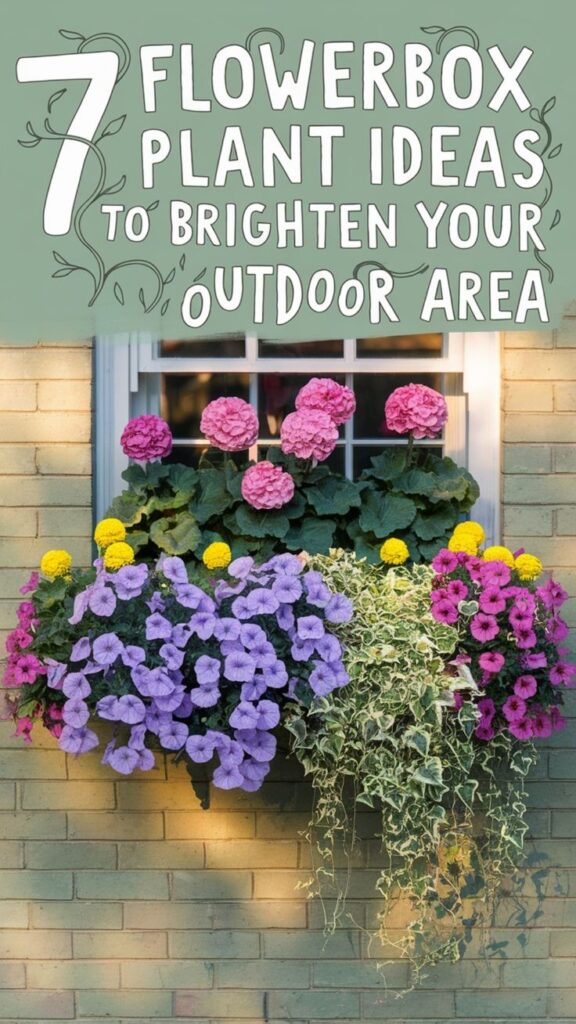
Contents
Sun-Loving Summer Stunners: A Bold Color Combination

A vibrant combination of red geraniums, purple petunias, and yellow lantana creates a stunning summer flowerbox display that thrives in full sunshine. These sun-loving plants complement each other perfectly, with the upright geraniums providing height, cascading petunias adding flowing texture, and spreading lantana offering dense coverage.
Together, they create a dramatic color palette that remains eye-catching throughout the summer months, providing continuous blooms from late spring until early fall.
- Light Requirements: Full sun (6-8 hours daily)
- Soil Type: Well-draining potting mix with added organic matter
- Water Needs: Regular watering when top inch of soil feels dry
- Fertilizer: Monthly feeding with balanced flower fertilizer
- Temperature Range: 65-85°F (18-29°C)
- Container Depth: Minimum 8 inches deep
- Spacing: Plant 6-8 inches apart for proper growth
To maintain this stunning combination, deadhead spent blooms regularly to encourage continuous flowering and prevent seed formation.
Trim back any leggy growth to maintain the desired shape and prevent the plants from becoming too stretched out. Monitor for common pests like aphids and spider mites, treating promptly with insecticidal soap if needed.
As the season progresses, pinch back the petunias if they become too long, and remove any yellowed or damaged foliage to keep the display looking fresh and healthy.
Shade-Friendly Flowerbox Favorites

Shade-friendly flowers offer vibrant options for flowerboxes in less sunny locations, bringing color and life to shadier spots on porches, balconies, or under trees.
These resilient plants have adapted to thrive with minimal direct sunlight, featuring varieties like impatiens with their delicate blooms, coleus with striking foliage patterns, begonias offering both attractive leaves and flowers, and the reliable fuchsia with its pendant-like blossoms.
- Light Requirements: 2-6 hours of filtered sunlight or bright indirect light daily
- Water Needs: Consistent moisture; soil should never completely dry out
- Soil Type: Well-draining, rich organic potting mix with good moisture retention
- Spacing: 6-8 inches between plants to allow proper air circulation
- Temperature Range: 60-75°F (15-24°C)
- pH Level: 6.0-6.5 for most shade-loving varieties
Regular deadheading of spent blooms encourages continuous flowering throughout the season, while monthly fertilization with a balanced, water-soluble fertilizer maintains steady growth.
Inspect leaves weekly for signs of powdery mildew, which can develop in shady, humid conditions, and maintain good air circulation by pruning overcrowded areas.
During hot spells, consider providing additional humidity through misting, and rotate containers periodically to ensure even growth patterns.
Year-Round Evergreen and Flowering Mix
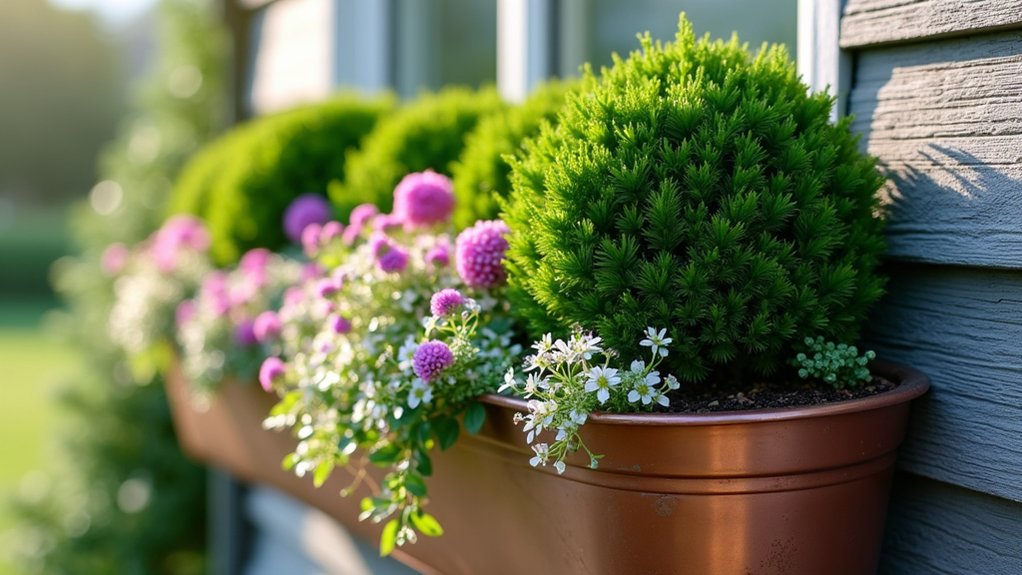
A year-round evergreen and flowering mix creates continuous visual interest in flowerboxes by combining sturdy evergreen plants with seasonal bloomers. This dynamic combination typically includes compact evergreen shrubs like boxwood or dwarf conifers as anchor plants, accompanied by flowering perennials and annuals that provide changing colors throughout the seasons.
The mix ensures the flowerbox maintains structure and fullness even when flowering plants are dormant, while offering bursts of color during blooming periods.
- Light requirements: Full sun to partial shade, depending on specific plant selections
- Water needs: Moderate, with consistent moisture but well-draining conditions
- Soil type: Rich, well-draining potting mix
- Container depth: Minimum 12 inches for proper root development
- pH level: 6.0-7.0 for most evergreen and flowering combinations
- Temperature range: Hardy in zones 5-9 for most combinations
- Spacing: 6-12 inches between plants, depending on mature size
Regular pruning of evergreens maintains their shape and prevents overcrowding, while deadheading spent blooms encourages continuous flowering.
Fertilize with a balanced, slow-release fertilizer in early spring and mid-summer, focusing on both foliage and bloom production.
Monitor soil moisture carefully during extreme weather conditions, as container plants are more vulnerable to temperature fluctuations.
Replace seasonal flowers as needed while maintaining the evergreen foundation plants for long-term stability.
Cascading Blooms for Dramatic Impact
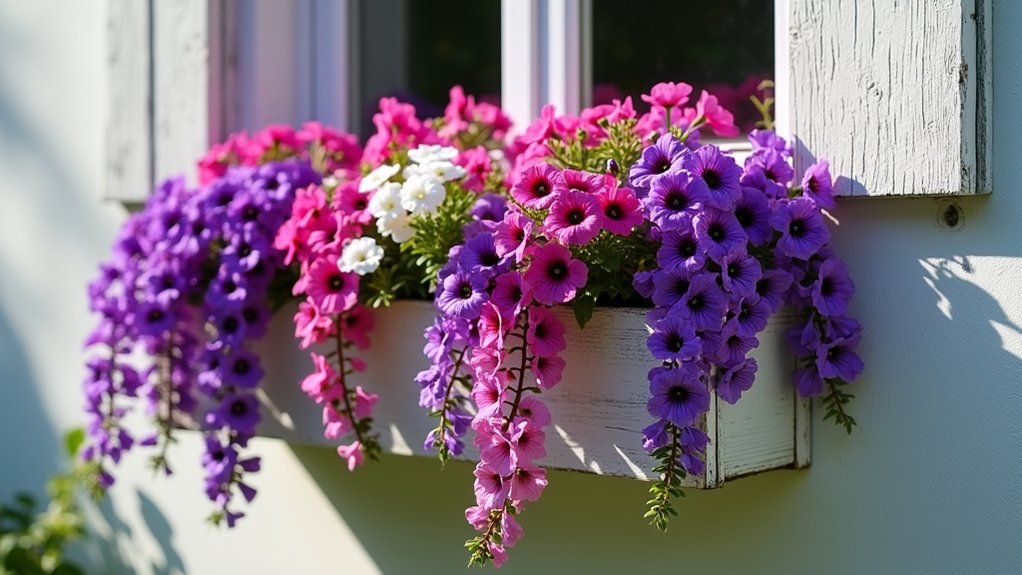
Cascading blooms create a stunning waterfall effect in window boxes and hanging planters, with trailing flowers spilling over the edges in vibrant waves of color.
These dramatic plants add vertical interest and soften harsh architectural lines while maximizing the visual impact of limited planting space. Popular cascading options include trailing petunias, lobelia, bacopa, calibrachoa, and ivy geraniums, which can trail up to 3 feet in length when properly maintained.
- Light: Most cascading bloomers need full to partial sun (6-8 hours daily)
- Water: Consistent moisture with well-draining soil; water when top inch feels dry
- Soil: Rich, well-draining potting mix with added organic matter
- Container: Boxes or baskets with adequate drainage holes
- Spacing: Plant 4-6 inches apart to allow spread
- Temperature: 65-75°F optimal growing range
- Fertilizer: Monthly balanced fertilizer during growing season
Regular deadheading of spent blooms and periodic trimming of leggy growth encourages fuller, more abundant flowering throughout the season.
Pinch back stems in early growth stages to promote branching and create denser coverage.
Monitor closely for signs of drought stress, particularly during hot weather, as cascading plants in elevated containers can dry out quickly.
Apply a layer of mulch around plants to help retain moisture and keep roots cool, while protecting against soil splash during watering.
Butterfly and Bee Attracting Blend
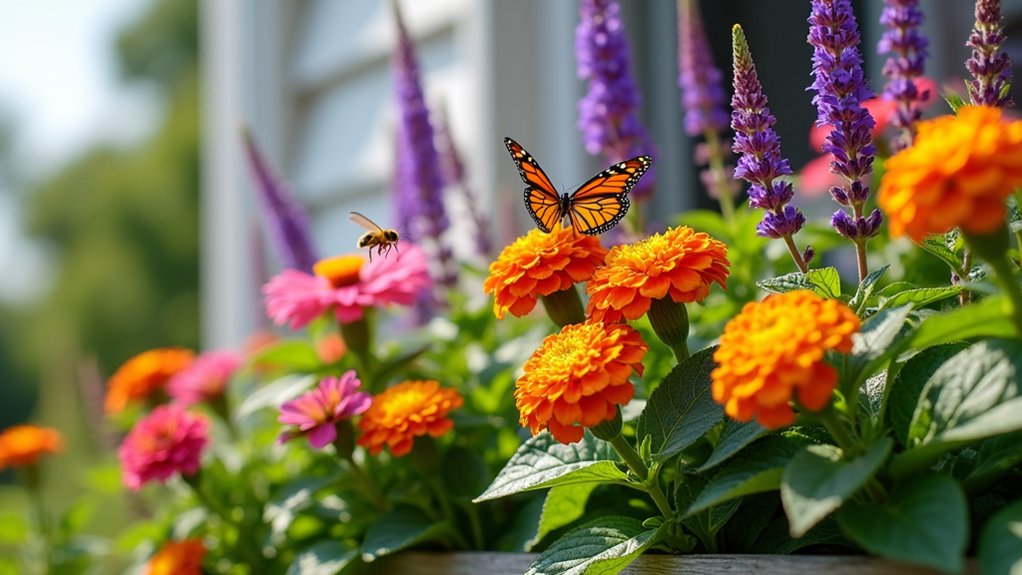
A butterfly and bee attracting blend creates a vibrant, pollinator-friendly flowerbox display featuring nectar-rich flowering plants in various heights and colors. Common choices include lantana, salvia, verbena, zinnia, and lavender, which work together to provide continuous blooming throughout the growing season.
These plants not only attract beneficial insects but also create a lively, dynamic display as butterflies and bees visit throughout the day.
- Full sun to partial sun (minimum 6 hours direct sunlight daily)
- Well-draining potting soil enriched with organic matter
- Regular watering to keep soil consistently moist but not waterlogged
- Spacing of 6-8 inches between plants to allow proper air circulation
- Container depth of at least 8 inches to accommodate root systems
- Protection from strong winds to prevent damage to delicate blooms
Regular deadheading of spent flowers encourages continuous blooming and prevents self-seeding.
Trim back leggy growth to maintain compact shape and prevent plants from overwhelming each other.
Apply a balanced, water-soluble fertilizer every two weeks during the growing season to support continuous flower production.
Consider installing small supports or stakes for taller varieties, and remove any diseased foliage promptly to prevent spread to neighboring plants.
Low-Maintenance Drought-Resistant Display
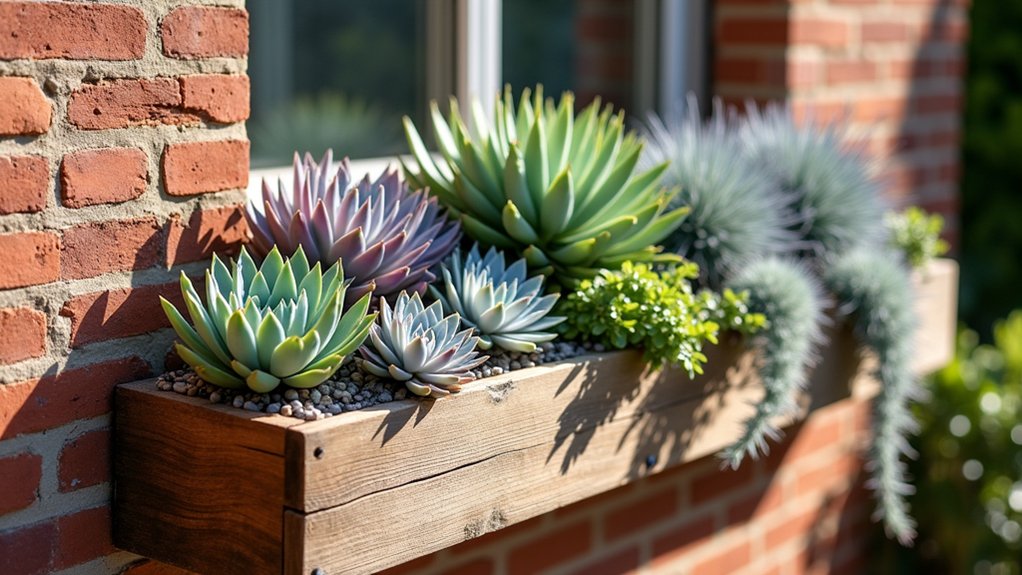
A low-maintenance drought-resistant flowerbox display combines hardy succulents, ornamental grasses, and Mediterranean plants that thrive with minimal care while creating visual interest.
This style typically features plants with varied textures and heights, such as trailing sedum, upright echeveria, and compact lavender, creating a layered look that remains attractive even in challenging conditions. The combination of silver-toned foliage, vibrant succulents, and occasional blooms provides year-round appeal without requiring constant attention.
Growing Conditions:
- Full to partial sun exposure, with at least 6 hours of direct sunlight daily
- Well-draining potting mix, preferably with added sand or perlite
- Limited watering schedule – once every 7-10 days in growing season
- Container must have drainage holes
- Optimal spacing between plants to prevent overcrowding
- Protection from excessive winter rainfall in humid climates
To maintain this drought-resistant display, remove any dead foliage promptly and trim back aggressive growers to maintain the desired shape.
Fertilize sparingly during the growing season using a balanced, slow-release fertilizer specifically formulated for succulents and drought-resistant plants. Monitor for signs of overwatering, such as yellowing leaves or stem rot, and adjust watering frequency accordingly.
During winter months, move containers closer to building walls for protection, and consider adding a layer of decorative gravel to enhance drainage and appearance.
Fragrant Flowerbox Garden Medley

A fragrant flowerbox garden medley combines aromatic flowering plants to create a sensory-rich display that delights both the eyes and nose. Popular fragrant combinations include lavender, sweet alyssum, heliotrope, and stock flowers, creating layers of color and varying heights.
These perfumed arrangements work particularly well near windows, entryways, or seating areas where their sweet scents can be fully appreciated throughout the growing season.
- Light: Full sun to partial shade, minimum 6 hours direct sunlight daily
- Water: Moderate watering, keeping soil consistently moist but not waterlogged
- Soil: Well-draining potting mix enriched with organic matter
- Temperature: 60-75°F (15-24°C) for optimal blooming
- Spacing: 4-6 inches between plants, depending on mature size
- Container: Minimum 8 inches deep with adequate drainage holes
- pH level: 6.0-7.0, slightly acidic to neutral
Regular deadheading of spent blooms encourages continuous flowering and prevents seed formation, keeping the display vibrant throughout the season.
Trim back leggy growth to maintain the desired shape and prevent plants from overwhelming their neighbors.
Feed plants with a balanced, water-soluble fertilizer every two weeks during the growing season, reducing to monthly during fall.
Inspect regularly for pests like aphids or spider mites, particularly in humid conditions, and treat promptly with insecticidal soap if needed.
